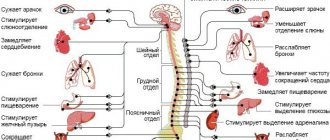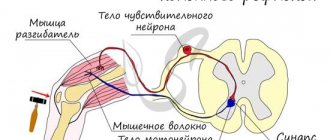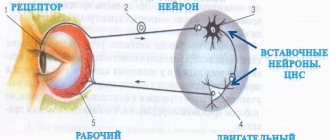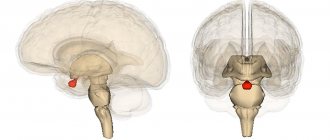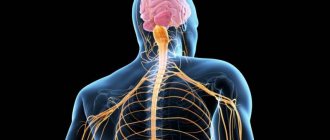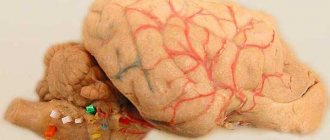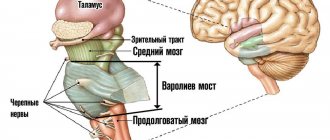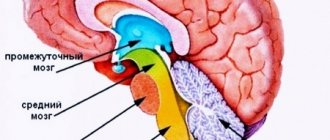Hypothalamic-pituitary dysfunction The basis of a woman’s reproductive system is an interconnected chain of neuroendocrine organs - the hypothalamus - pituitary gland - ovary, the correct functioning of which ensures the maturation of a full-fledged egg, changes in the structure of the endometrium necessary for normal implantation of the embryo, the correct functioning of the epithelium of the fallopian tubes to promote the fertilized egg into the uterus, implantation and maintenance of early pregnancy.
The highest organ of regulation of the hypothalamic-pituitary-ovarian system is the central nervous system, which through a whole complex of direct and reverse interactions ensures the stable operation of the reproductive system.
The hypothalamus (brain structure) is the center of regulation of the menstrual cycle. With the help of releasing hormones, the hypothalamus controls the functioning of the underlying gland, the pituitary gland. The pituitary gland, in turn, regulates the functioning of all endocrine glands - it produces follicle-stimulating hormone (FSH), luteinizing hormone (LH), thyroid-stimulating hormone (TSH). Under the influence of pituitary hormones (FSH, LH and prolactin), cyclic changes occur in the ovaries: egg maturation and ovulation. With most hypothalamic-pituitary diseases, women develop menstrual dysfunction until the cessation of menstruation.
How the hypothalamic-pituitary system works: features of regulation, functions, processes
The action of the hypothalamic-pituitary system is possible due to the constant communication between these organs. Here are the features of the regulation of processes and functions of this axis:
- Hypothalamus
As a structure of the nervous system, it constantly receives a huge amount of information from all parts of the body. In response, it can generate different types of reactions - stimulating other areas of the brain or producing a hormone, a chemical particle that can carry information. Here are some other processes that occur in this part of the brain:
- Pituitary
An important mediator in the hormonal activity of the hypothalamus. Hormones from the hypothalamus reach the pituitary gland in two ways. The first is the direct transmission of hormones along nerve fibers. This is how vasopressin and oxytocin are transported. Once produced in the hypothalamus, they are sent to the posterior pituitary gland, from where they then enter the bloodstream.
The second method is with those hormones of the hypothalamus that control the functioning of the pituitary gland. These include various subtypes of releasers (excitatory hormones) and statins (inhibitory hormones). Hypothalamic liberins and statins travel from the hypothalamus to a special network of tiny blood vessels through which they travel directly to the pituitary gland. When in contact with the cells of the anterior pituitary gland, they regulate their activity and the production of pituitary hormones.
Although the hypothalamus is the primary structure of the hypothalamic-pituitary axis, the connection can be bidirectional. The pituitary gland also has the ability to influence the hypothalamus. The adjustment of the entire axis is based on so-called positive and negative feedback. When hormones are released from the pituitary gland, their blood levels increase and the hypothalamic-pituitary axis is suppressed. On the other hand, if this hormone is needed, the hypothalamus stimulates the pituitary gland and increases its secretory activity. The correct functioning of the feedback system is a necessary condition for maintaining homeostasis, that is, the internal balance of our body.
Hypothalamic-pituitary hormones in the human body
The hypothalamic-pituitary axis is a “two-story” system with many interconnections. None of its structures will be able to perform its function independently. The hypothalamic-pituitary axis is a powerful tool that regulates the entire hormonal balance of our body. The most important hormones in the human body, produced by the hypothalamus and pituitary gland:
- Oxytocin, vasopressin (ADH)
- Somatoliberin (GH-RH)
- Somatostatin (GH-IH)
- Corticoliberin (CRH)
- Thyroid hormone (TRH)
- Gonadoliberin (GnRH)
- Prolactoliberin (PRH)
- Prolactostatin (PIH)
As you can see, the hypothalamic-pituitary axis determines the functioning of the entire body through a huge number of hormones. The most important functions of hormones along this axis are presented below.
- Oxytocin
Oxytocin and vasopressin are two hormones of the hypothalamus that do not affect the pituitary gland. The role of the pituitary gland is only to store them. Once they receive the appropriate signal, they enter the bloodstream. Oxytocin is the hormone that plays the most important role during childbirth. It promotes contraction of the uterus. The second task of oxytocin is to facilitate lactation. The baby's sucking of the nipple stimulates the release of oxytocin into the mother's blood, which leads to the secretion of milk from the mammary glands.
- Vasopressin
Also known as antidiuretic hormone (ADH). It is a hormone that regulates the body's water balance. As the name suggests, antidiuretic hormone reduces urine output. Vasopressin is released when you become dehydrated, when your blood thickens, or when your blood pressure drops. By acting on the kidneys, vasopressin increases the density of diuresis. Thanks to this, you can save water and store it inside the body.
- Somatoliberin
This is the first example of a typical hormone of the hypothalamic-pituitary system. Produced in the hypothalamus, somatoliberin reaches the pituitary gland and stimulates its cells to secrete pituitary somatropin, also known as growth hormone. The somatotropin-somatotropin-releasing axis ensures the growth and development of all body tissues, which, in turn, determines the correctness of the growth process.
- Somatostatin
It is a hormonal opponent of somatoliberin. Its effect on the pituitary gland leads to a decrease in the release of growth hormone. In addition to its functions in the hypothalamic-pituitary axis, somatostatin is also produced locally in the gastrointestinal tract, where it inhibits, for example, the release of intestinal hormones.
- Corticoliberin
Known as corticotropin releasing hormone (ACTH). It is part of the hypothalamus-pituitary-adrenal system. Most active in stressful situations. The effect of ACTH on the adrenal cortex increases the release of one of the most important “stress hormones” - cortisol. The corticotropin-corticotropin-adrenal axis also regulates the metabolic balance of the entire body.
- Thyroid hormone
It is a hormone that causes the release of thyroid-stimulating hormone (TSH) from the pituitary gland. Thyrotropin levels are one of the markers indicating current thyroid function and are often measured in patients with thyroid disease. Thyrotropin stimulates the development of the thyroid gland and increases the secretion of its hormones. This in turn affects our heart rate, gastrointestinal function, nutrient metabolism and daily activities.
- GnRH
The role of GnRH in the hypothalamic-pituitary system is to stimulate the production of the so-called pituitary gonadotropin. These include: follicle-stimulating hormone (FSH) and lutropin (LH). GnRH is an example of a hormone secreted in a pulsatile rhythm, and the frequency of this rhythm is determined by the type of gonadotropin secreted. A low frequency of GnRH pulses causes the secretion of FSH, and a high frequency of LH (this occurs, for example, in women immediately before ovulation). Pituitary gonadotropins influence the ovaries of women and the testes of men, determining proper puberty and reproduction.
- Prolactoliberin
This is a hypothalamic hormone that stimulates pituitary cells to produce prolactin. Prolactin is the main factor that prepares the mammary glands for the process of lactation. The secretion of prolactin by the pituitary gland is a good example of a negative feedback mechanism in the hypothalamic-pituitary axis. During lactation, when prolactin levels in the body are highest, gonadotropin production is again suppressed. It is for this reason that breastfeeding women do not menstruate after childbirth.
- Prolactostatin
The hormone that inhibits prolactin release is generally not a typical hypothalamic statin. Its function is performed by the neurotransmitter dopamine. This is increased dopaminergic signaling in the hypothalamic-pituitary axis, which reduces the production of prolactin.
The causes of insufficiency of the luteal phase of the menstrual cycle are diverse.
Luteal phase deficiency occurs in 25% of cases of endocrine infertility. Treatment of infertility in patients with luteal phase deficiency is carried out by prescribing progesterone drugs.
Progesterone is of great importance in the female reproductive system. It is responsible for creating an environment favorable for conception in the uterine area, helps implant the fertilized egg and retains a substance that strengthens the embryo throughout the entire period of gestation. But in cases where the normal amount of the hormone is exceeded, the woman may experience unpleasant symptoms such as a mammary cyst. In these cases, prescribe ultrasound of mammary glands for eco
Disorders of the hypothalamic-pituitary system: pathologies of increased hormone concentrations
Gigantism: Disorders of the Hypothalamic-Pituitary System
Although hormone levels in the hypothalamic-pituitary axis are mutually controlled, their regulatory mechanisms sometimes do not work. Disorders of the hypothalamic-pituitary system develop. As a result, a person deals with endocrine pathologies that arise as a result of an excess or deficiency of hypothalamic-pituitary hormones. Here are diseases that develop due to pathologies of increased concentrations of hormones of the hypothalamic-pituitary axis:
- Syndrome of inappropriate vasopressin production
An example of excessive activity of hypothalamic hormones is precisely the syndrome of inappropriate vasopressin production (SIADH). As a result of too high a concentration of this substance, there is increased water retention in the body and dilution of body fluids. SIADH syndrome mainly causes neurological symptoms, and in its advanced form can lead to cerebral edema.
- Hyperthyroidism or hyperfunction of the adrenal glands
Increased levels of hormones of the hypothalamic-pituitary system can lead to secondary hyperfunction of other endocrine glands - hyperthyroidism or adrenal hyperfunction. High concentrations of ACTH can cause so-called ACTH-dependent Cushing's syndrome. Secondary hyperthyroidism leads to the following conditions: increased heart rate, excessive weight loss, and diarrhea. Excessive psychomotor excitability also occurs.
- Gigantism or acromegaly
Often occurs against the background of these violations. And it happens to both men and women.
- Infertility
An increased concentration of prolactin, that is, hyperprolactinemia, is one of the most common hormonal causes of infertility. Prolactin suppresses the secretion of pituitary gonadotropins, which, in particular, leads to ovulation disorders.
- Pituitary adenomas
The most common cause of elevated pituitary hormone levels is pituitary adenomas, which escape the control of the hypothalamic-pituitary system and produce hormones independently of it. Their symptoms may result from elevated levels of one hormone or an overlapping excess of several types of hormones. Increased levels of peripheral hormones, such as cortisol or thyroid hormones, always require the exclusion of dysfunction of the hypothalamic-pituitary axis, which may be the cause of these disorders.
Diagnosis of hypothalamic-pituitary dysfunction
To diagnose disorders in the hypothalamic-pituitary-ovarian system, a full range of clinical, laboratory, biochemical and hormonal blood tests and an X-ray of the skull (the area of the sella turcica, where the pituitary gland is located, in order to exclude prolactinoma) are required. Measuring basal temperature with plotting a graph is informative. During the period of ovulation, there is an increase in rectal temperature by an average of 1°C. If the luteal phase is insufficient, there is a shortening of the second phase of the cycle, the temperature difference in both phases of the cycle is less than 0.6°C. An ultrasound examination of follicle growth and endometrial thickness is performed on certain days of the menstrual cycle. An endometrial biopsy is performed 2–3 days before the onset of menstruation, which makes it possible to determine the morphological maturation of the endometrium.
An informative method for studying the pituitary gland is computed tomography. Computed tomography of the sella region allows us to identify changes in the density of the pituitary gland, differentiate micro- and macroadenomas, “empty” sella and cysts from normal pituitary tissue.
Magnetic resonance imaging is used to diagnose neoplasms of the hypothalamic-pituitary region. Magnetic resonance imaging makes it possible to distinguish the stalk of the pituitary gland, the slightest changes in the structure of the pituitary gland, individual cysts, cystic tumors, hemorrhages, and cystic degeneration of the pituitary gland. The advantage of magnetic resonance imaging is the absence of x-ray radiation, which makes it possible to repeatedly examine the patient over time.
Disorders of the hypothalamic-pituitary system: decreased concentration of hormones
A disease with a mechanism opposite to the SIADH described above is diabetes insipidus. The cause of this disease is a deficiency of vasopressin produced in the hypothalamus, caused by dysfunction of hypothalamic cells. Such disorders of the hypothalamic-pituitary system are very common.
- Decreased vasopressin levels make urinary water loss uncontrollable.
- The amount of urine produced increases significantly, leading to symptoms of dehydration and a constant feeling of thirst.
A deficiency of pituitary hormones can cause symptoms of secondary endocrine gland insufficiency:
- Thyroid gland
- Adrenal glands
- Gonad
Worth knowing: Decreased gonadotropin levels can cause infertility and sexual dysfunction.
Deficiency of thyrotropin leads to secondary hypothyroidism, which manifests itself in the form of chronic fatigue, weight gain and constipation. Reduced levels of growth hormone have serious consequences, especially in children, delaying the growth process. On the other hand, prolactin deficiency can lead to lactation disorders. Hypopituitarism rarely manifests itself as a deficiency of a single hormone. More often, damage to this gland leads to a decrease in the production of several hormones. Pituitary dysfunction can have various causes. These include:
- Injuries
- Neoplasms infiltrating the pituitary gland
- Bleeding
- Congenital diseases (for example, hypoplasia, that is, underdevelopment of the pituitary gland)
When diagnosing a hormonal deficiency, you should always remember to check the functioning of the hypothalamic-pituitary axis (by measuring hormone levels of this axis). Thanks to this, it is possible to determine whether the deficiency of a particular hormone is the result of a violation of its peripheral production or a central violation of the hypothalamic-pituitary regulation.
Luteal phase deficiency
One of the causes of hypothalamic-pituitary dysfunction is luteal phase deficiency (LPF) of the menstrual cycle. This pathology occurs when the corpus luteum produces an insufficient amount of progesterone, which leads to an incomplete change in the structure of the endometrium necessary for normal implantation of the embryo, disruption of the functioning of the epithelium of the fallopian tubes to promote the fertilized egg into the uterus, disruption of the implantation process due to the fine structure of the endometrium. This can lead to endocrine infertility, the appearance of scanty bleeding 4-5 days before the start of the next menstruation, or to spontaneous miscarriage in the early stages of pregnancy (6-7 weeks).
A hormonal manifestation of luteal phase deficiency is a decrease in the production of progesterone by the corpus luteum, accompanied by normal or increased secretion of estradiol. At the cellular level, luteal phase deficiency is manifested by increased cell division (endometrium, mammary gland, myometrium). Clinically, luteal phase deficiency is manifested by premenstrual syndrome, menstrual irregularities, decreased fertility, benign breast tumors and uterine fibroids. The causes of infertility with luteal phase deficiency are insufficient endometrial maturity, which impedes normal egg implantation, and low progesterone levels, insufficient to support early pregnancy.
To carry out IVF with pituitary microadenoma, as in patients without such a diagnosis, ovulation stimulation is carried out, which is not contraindicated for this diagnosis, subject to successful therapy. Preference for this manipulation is given to gonadotropin preparations.
